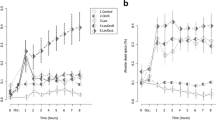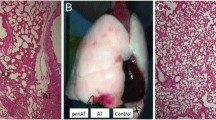Abstract
The intrapulmonary distribution of the inhalation-to-perfusion ratio (I/P) was studied after placement of an obstruction in a sublobar bronchus (SLO) or in a lobar bronchus (LO) in 17 anesthetized prone (sternal recumbent) dogs. Placement of an SLO or LO did not induce any significant changes in the standard ventilatory and hemodynamic parameters measured. With the use of99mTc aerosol inhalation combined with99mTc perfusion lung scintigraphy, parameters quantifying the inhalation (I) to perfusion (P) mismatching at regional as well as at intraregional levels were calculated. The SLO increased the relative ventilation to the lung containing the obstruction, induced a shift of blood from the obstructed segment to the rest of the same lung, and increased the ratio between the mean I and the mean P (regional mismatching factor) in both the obstructed segment and the lung containing the obstruction.
The LO diverted air and blood away from the obstructed lobe to the contralateral lung, but blood to a lesser extent. The LO decreased the regional mismatching factor in the obstructed lobe but also in the lung containing the obstruction. It also increased significantly the intraregional I to P mismatching in the obstructed lobe as well as in the rest of the same lung. After withdrawal of LO and reinsufflation of the collapsed lobe, blood continued to leave this lobe, while the withdrawal of SLO allowed recovery of the initial perfusion. This suggests that both hypoxic vasoconstriction and mechanical factors such as vascular distortion are involved in the blood shifts observed, and require some delay to be relieved. It is concluded that in dogs compensating mechanisms such as collateral ventilation are very effective. In case of SLO, I to the lung involved is increased. In case of LO, vasoconstriction in response to alveolar hypoxia could not fully compensate for the decreased I to the obstructed lobe.
Similar content being viewed by others
References
Barer GR, Howard P, Mc Currie JR, Shaw JW (1969) Changes in the pulmonary circulation after bronchial occlusion in anesthetized dogs and cats. Circ Res 25:747–764
Benumof JL (1979) Mechanism of decreased blood flow to atelectatic lung. J Appl Physiol 46:1047–1048
Clercx C (1988) Scintigraphical studies of lung function in dogs. Thesis, University of Utrecht, The Netherlands
De Vries HW (1976) Anesthesia and monitoring of the dog in cardiovascular research. Thesis, University of Utrecht, The Netherlands
Flenley DC, Picken J, Welchel L, Ruff L, Corry PM, Macklem PT (1972) Blood gas transfer after small airway obstruction in the dog and minipig. Respir Physiol 15:39–51
Francis RA, Agnew JE, Sutton PP, Pavia D, Clarke SW (1981) Ventilation imaging with easily prepared99mTc aerosols. Nucl Med Commun 2:203–208
Glasser SA, Domino KB, Lindgren L, Parcella P, Marshall C, Marshall BE (1983) Pulmonary blood pressure and flow during atelectasis in the dog. Anesthesiology 58:225–231
Hayes M, Taplin GV, Chopra SK, Knox DE, Elam D (1979) Improved radio-aerosol administration system for routine inhalation lung imaging. Radiology 131:256–258
Hilpert P (1970) Collateral ventilation. Habilitationsschrift, University of Tubingen, West Germany
Hobbs BB, Hinchcliffe WA, Greenspan RH (1972) Effects of acute lobal atelectasis on pulmonary hemodynamics. Invest Radiol 7:1–10
Kuriyama T, Latham LP, Horwitz LD, Reeves JT, Wagner WW (1984) Role of collateral ventilation in ventilation-perfusion balance. J Appl Physiol 56:1500–1506
Lambert MW (1955) Accessory bronchiole-alveolar communications. J Pathol Bacteriol 70:311
Macklem PT (1971) Airway obstruction and collateral ventilation. Physiol Rev 51:368–436
Martin HB (1966) Respiratory bronchioles as the pathway for collateral ventilation. J Appl Physiol 21:1443
McFarlane PA, Gardaz JP, Sykes MK (1984) CO2 and mechanical factors reduce blood flow in a collapsed lung lobe. J Appl Physiol 57:739–743
Menkes HA, Traystman RJ (1977) Collateral ventilation (state of the art). Am Rev Respir Dis 116:287–309
Metcalf JB, Wagner PD, West JB (1978) Effect of local bronchial obstruction on gas exchange in the dog. Am REv Respir Dis 117:85–95
Peake MD, Harabin AL, Brennan NJ, Sylvester JT (1981) Steady-state vascular response to graded hypoxia in isolated lungs of five species. J Appl Physiol 51:1214–1219
Pirlo AF, Benumof JL, Trousdale FR (1981) Atelectatic lobe blood flow: open vs. closed chest, positive pressure vs. spontaneous ventilation. J Appl Physiol 50:1022–1026
Robinson NE (1982) Some functional consequences of species differences in lung anatomy. Adv Vet Soc Comp Med 26:1–32
Sykes MK, Arnot RN, Jastrzebski J, Gibbs JM, Obdrzalek J, Hurtig JB (1975) Reduction of hypoxic pulmonary vasoconstriction during trichloroethylene anesthesia. J Appl Physiol 39:103–108
Thomas HM, III Garrett RC (1982) Strength of hypoxic vasoconstriction determines shunt fraction in dogs with atelectasis. J Appl Physiol 53:44–51
Venker-van Haagen AJ (1979) Bronchoscopy of the normal and abnormal canine. J Am Anim Hosp Assoc 15:397–410
Voelkel NF (1986) Mechanisms of hypoxic pulmonary vasoconstriction. Am Rev Respir Dis 133:1186–1195
Van den Brom WE, Clercx C, von Toor AJ, de Vries HW (1988) Quantitative Analysis of radioaerosol inhalation and perfusion scintigraphy in dogs. Lung 167:201–212
Author information
Authors and Affiliations
Rights and permissions
About this article
Cite this article
Clercx, C., van den Brom, W.E., Stokhof, A.A. et al. Pulmonary scintigraphy in canine lobar and sublobar airway obstruction. Lung 167, 213–224 (1989). https://doi.org/10.1007/BF02714950
Accepted:
Issue Date:
DOI: https://doi.org/10.1007/BF02714950




